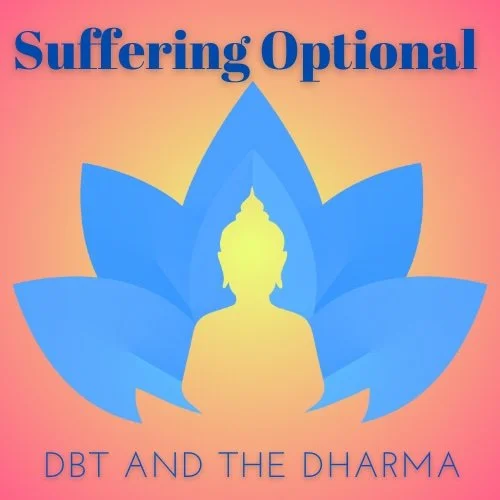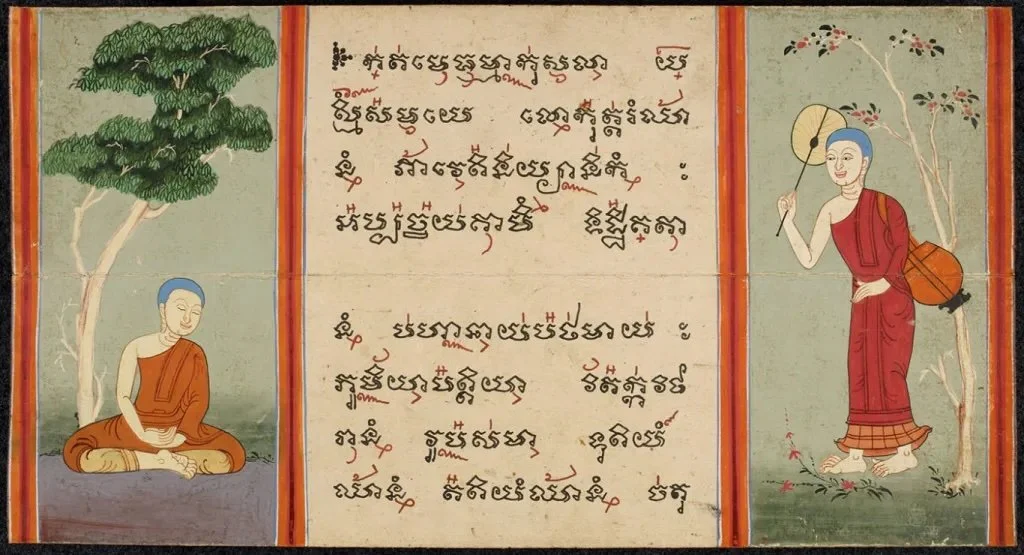Suffering Optional Episode 1: DBT: The Buddha’s Brainchild
Introducing Diana & Maddie, DBT, Buddhist Psychology and Buddha Nature
In this first episode of Suffering Optional, we introduce the premise of the podcast: exploring the intersection between Dialectical Behavior Therapy (DBT) and Buddhist psychology. Diana walks us through the basics of DBT, explaining how it helps manage intense emotions, while Madeline offers a glimpse into Buddhist psychology and how it connects with DBT. The conversation wraps up with an insightful discussion on “Buddha nature,” the belief that we all have an innate ability to free ourselves from suffering. This episode sets the foundation for what’s to come, blending practical DBT skills with timeless wisdom from Buddhism.
How to Listen
Episode 1: DBT, the Buddha’s Brain Child is available wherever you get your podcasts. Here are links to it on Spotify and Apple Podcasts.
Buddha Nature
Buddha nature refers to the inherent potential within all of us to awaken, or in more practical terms, to relieve ourselves from suffering. It’s a recognition that we all have the capacity for peace and liberation, no matter how deep the pain or confusion. Maddie describes this beautifully in Episode 1: “We all have this capacity to wake up, to be free from suffering.” Connecting with your Buddha Nature isn’t about becoming someone different, but rather about recognizing the wisdom and strength already within us. In DBT we would refer to this as your “Wise Mind”. Some might call it your “higher self” or you essential self.
Connecting with our Buddha nature is immensely helpful because it allows us to step back from suffering, even in the most challenging moments. By accessing this part of ourselves, we tap into our wise mind, finding the strength to handle pain without adding the layers of suffering we often cling to.
Pali Translations (as promised)
In each episode, Maddie introduces important terms from Buddhism. These terms are the original words from Pali Sanskrit.
Pali Sanskrit
Pali is an ancient language, closely related to Sanskrit, and is traditionally considered the language of the Buddha’s teachings. It forms the basis of the Tipitaka or Pali Canon, the authoritative texts of Theravada Buddhism, which preserve the earliest recorded discourses of the Buddha. Pali holds great significance because it connects modern practitioners with the original words and wisdom of the Buddha.
In contemporary Buddhism, Pali remains an important language for scholars, monks, and practitioners, particularly in Theravada traditions, which flourish in countries like Sri Lanka, Thailand, and Myanmar. Although it’s not spoken conversationally, it continues to be studied, chanted, and used in meditation practices to reflect on the Buddha’s teachings in their purest form.
Theravada Buddhism
Theravada Buddhism, the oldest surviving branch of Buddhism, traces its origins back to the teachings of the Buddha around the 5th century BCE in India. It spread to Sri Lanka, Myanmar, Thailand, Cambodia, and Laos, where it remains the dominant form of Buddhism. Unlike other branches, such as Mahayana and Vajrayana, Theravada focuses on the original Pali Canon, emphasizing personal meditation, ethical conduct, and attaining enlightenment through one’s efforts, rather than relying on external forces like bodhisattvas. It retains a more conservative approach to the Buddha’s teachings, prioritizing the path of mindfulness and wisdom (vipassana) for spiritual liberation.
In the United States, Theravada has gained popularity due to its practical meditation techniques and compatibility with Western mindfulness practices. Teachers like Jack Kornfield and Joseph Goldstein have played pivotal roles in introducing Theravada’s emphasis on insight meditation, making it accessible to those seeking mental clarity and stress relief.
Dharma
In Buddhism, the Dharma refers to the teachings of the Buddha, encompassing the truths and principles that guide individuals toward enlightenment. At its core, the Dharma addresses the nature of suffering (dukkha), its causes, and the path to freedom through the Eightfold Path. It provides practical methods for transforming the mind and cultivating wisdom, ethical conduct, and mindfulness. The Dharma’s value lies in its universality—it doesn’t require belief in a higher power, but instead offers tools for individuals to directly experience insight and inner peace through practice.
The ultimate goal of practicing the Dharma is to attain liberation from the cycle of suffering and rebirth (samsara), offering profound clarity and compassion. In everyday life, the Dharma is helpful because it encourages a balanced, ethical, and mindful way of living, reducing stress and leading to greater emotional resilience. Its timeless relevance is why it continues to resonate across cultures, helping individuals live with more awareness, peace, and purpose. The point of the Dharma is not just intellectual understanding, but actual transformation through experience, leading toward awakening and deep interconnectedness with all beings.
Nibbana (Nirvana)
In Theravada Buddhism, Nibbāna (or Nirvana in Sanskrit) represents the ultimate goal—complete liberation from suffering. It is often described as the extinguishing of the “fires” of greed, hatred, and delusion, which are the root causes of suffering. Enlightenment in Theravada is not an abstract concept; it is a transformative experience where one fully realizes the nature of reality, free from attachment and clinging. It involves the dissolution of the ego, the false sense of self, and the direct experience of impermanence, suffering, and overly identifying with the self.
In modern life, Nibbāna may seem distant, but its principles are deeply relevant. The practice of mindfulness and ethical living helps reduce personal suffering by fostering awareness and compassion. Meditation and moral discipline are pathways to cultivating a peaceful mind, which, though not the same as full enlightenment, can bring significant relief from life’s stresses and challenges. Progress toward Nibbāna happens gradually as one aligns their life with the Dharma—by letting go of harmful attachments and embracing a deeper sense of interconnectedness and wisdom.









